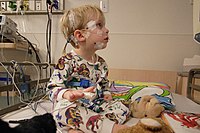
Photo from wikipedia
Disorders of arousal (DOA) is an umbrella term initially covering classical sleepwalking, sleep terrors, and confusional arousals, and now including a wider spectrum of specialised forms of non rapid eye… Click to show full abstract
Disorders of arousal (DOA) is an umbrella term initially covering classical sleepwalking, sleep terrors, and confusional arousals, and now including a wider spectrum of specialised forms of non rapid eye movement (non REM) parasomnias such as sexsomnia, sleep‐related eating disorder, and sleep‐related choking syndrome. Growing evidence has shown that DOA are not restricted to children but are also prevalent in adults (2%–4% of the adult population). While DOA run in family, genetics studies remain scarce and inconclusive. In addition to the risk of injury on themselves and others (including sexual assaults in sexsomnia), adults with DOA frequently suffer from excessive daytime sleepiness, pain, and altered quality of life. The widespread view of DOA as automatic and amnesiac behaviours has now been challenged by subjective (dream reports) and objective (dream‐enacting behaviours documented on video‐polysomnography) observations, suggesting that sleepwalkers are ‘dream walking’ during their episodes. Behavioural, experiential, cognitive, and brain (scalp electroencephalography [EEG], stereo‐EEG, high density‐EEG, functional brain imaging) data converge in showing a dissociated pattern during the episodes. This dissociated pattern resembles the new concept of local arousal with a wake‐like activation in motor and limbic regions and a preserved (or even increased) sleep intensity over a frontoparietal network. EEG and behavioural criteria supporting the DOA diagnosis with high sensitivity and specificity are now available. However, treatment is still based on controlling priming and precipitating factors, as well as on clinicians’ personal experience with sedative drugs. Placebo‐controlled trials are needed to improve patients’ treatment. DOA deserve more attention from sleep researchers and clinicians.
Journal Title: Journal of Sleep Research
Year Published: 2022
Link to full text (if available)
Share on Social Media: Sign Up to like & get
recommendations!